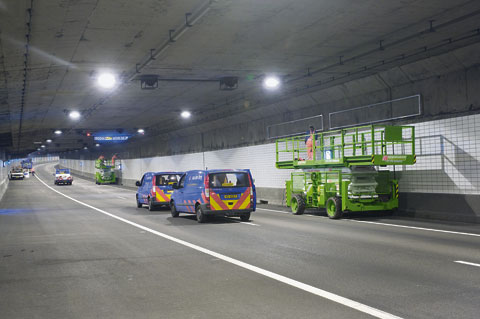De
lta and Delft Integraal/Outlook often write about innovative ideas that offer great promises for the future. But what has happened to them a couple of years on? What for instance has happened to the Dust Magnet, a dust reduction system developed and patented by Bob Ursem, director of TU Delft’s Botanical Garden?
Delta April 5th 2007
‘By electrically charging dust particles, Ursem can extract them from the air, as if by using a magnet. Last month he applied for a worldwide patent on his invention.’
The system has just been tested on a large scale, Bob Ursem reports, and before long he is quickly offering all the details in a torrent of enthusiasm. In the simplest form, Ursem’s dust reduction system consists of one or more high voltage conducting wires and a couple of electrically grounded conducting grids. Dust particles passing by the wires get robbed of a couple of electrons and thus acquire an electrical charge (there is a current of some microamperes flowing through the system). As a result, the dust particles are electrostatically drawn to the grounded electrodes, and thus dust particles of all sizes are extracted from the air. This process benefits air quality, as the health risks of fine particulate dust are increasingly acknowledged and regulated. Ursem’s dust reduction system was developed with motorways in mind, but a number of other applications can be imagined, ranging from building sites to operation theatres.
Ursem conducted his first life-size outdoor test in Zwammerdam, where he managed to reduce the amount of airborne particles by sixty percent. He then further developed the system with the help of his colleagues at the faculty of Applied Sciences’ Botanical Garden section, dr. Rijn Roos and dr. Jan Marijnissen. The researchers scaled up the system and set up a large-scale test in a tunnel, in collaboration with BAM, a construction company, and various Dutch ministries.
This test, which has recently been completed, began on July 9th in the northern tube of the Thomassen Tunnel in the Europoort port and industrial area. Twenty-four aluminum frames were attached on one side of the tunnel and connected to a thirty kilovolt source, while an equal number of frames on the other side of the tunnel were grounded. For the system to have worked, dust particles would have been drawn from the air to the grounded frames. A number of particle detectors monitored the dust levels in the middle and at both ends of the tunnel. Reference data were collected with the electricity switched off.
And the result? “I can’t tell!” Ursem says, laughing. “I can’t tell but it looks really good.” The final report will be completed on November 5th, but the results will only be published at the IPL (Innovation Programme for Air Quality) congress on November 25th. Ursem: “After that it’s up to the politicians. But I would expect the first contracts to be put out to tender in January.” So, it must work then? “No comment!” Ursem says, laughing again and clearly enjoying himself.
Erwin en Githa Stok
Willemstraat 36
Buren van het studentenhuis op nummer 38
Het jonge stel Stok heeft vijfenhalf jaar buurervaring met de drie jongens naast hen. “We hebben geen overlast van ze, soms staat een radio hard aan in de zomer”, zegt Erwin Stok. “Maar ik ben af en toe bezig met mijn Volkswagenbusje en het lawaai van een slijptol dringt pas echt ver door.” Zijn vrouw voegt er aan toe dat de jongens zelfs van pas komen bij zijn autohobby, omdat er regelmatig wat gesjouwd moet worden.
Goed sociaal contact, dus. In de zomer barbecueën ze zo nu en dan met elkaar. “Alleen als we bij ze binnen zijn weet je niet waar je moet zitten tussen al die zooi. Maar dat hoort bij studentenhuizen.”
Stok vertelt dat zijn vrouw en hij wel eens een rondleiding mochten geven in het studentenhuis, onder het motto: zo leven studenten. “Het huis is wel opgeknapt, want aanvankelijk groeide de schimmel op de muren en hing de pasta aan het plafond.”
Ooit hebben de jongens twee tegels van de Stoks verruild voor een bloemenperkje in het kader van de actie ‘fleur je buurt op’. Daar kon Erwin Stok de humor niet van inzien. “Ik kan wel lachen als ze in een roze tutu ofzo het huis verlaten op weg naar een feestje.”
Githa Stok heeft de buurjongens de afgelopen jaren volwassen zien worden, zegt ze. “Hoewel ze op de laatste huisreünie de auto van een oud-huisgenoot bekladden met satésaus.”



Comments are closed.